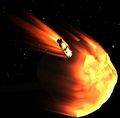Asteroid
An asteroid is a randomly created celestial body with sizes between 3 and 30 meters.
This is the first type of celestial body that is not on rails to change their orbits. This means that they can be captured by other bodies or collide with them. The current Kerbol System is designed to prevent any SOI change which would disturb their orbit. Unlike the other celestial bodies, asteroids are too light to have any gravity. This makes them more like a non-player created craft. But they need to be discovered and monitored with the Tracking Station. They come in various classes from class A (tiny) to class E (Huge). Asteroids can be white, black and grey and come in random shapes. Asteroids are parts, as opposed to celestial bodies. The part configuration file which is used as a prototype for each procedurally-generated asteroid can be found in GameData/NASAmission/Parts/PotatoRoid/.
Asteroids should not be confused with captured asteroids, as they are on rails and have gravity.
Capturing asteroids
The update in which asteroids were released is called Asteroid Redirect Mission. The general notion is to rendezvous with an asteroid and attach to it with an Advanced Grabbing Unit. The craft can then use its engines to alter the orbit of the asteroid. This can be used to get it into a stable orbit around Kerbin or another celestial body and even land it. Capturing an Asteroid is similar to docking.
The rendezvous is identical to the usual docking with targeting the asteroid and reducing the relative inclination. Although docking or grappling with an escaping target is more difficult, because the instrumentation isn't really implemented to do that sort of docking. On close approach instead of targeting a specific docking port the center of mass needs to be target when the asteroid should be moved. Once grappled it simply behaves as though the ship needs to get a closed orbit and retrograde until it is no longer an escape trajectory.
Depending on the size, exactly hitting the center of mass is not crucial, because the Advanced Grabbing Unit can be tilted to point the thrust better along the center of mass. And when the asteroid is smaller, the unit needs to be gimballed less.
Science
Kerbals which fly close to an asteroid during an EVA can take samples from each asteroid to a maximum of 70 Science. Different samples of equal value can be collected from the same asteroid in different situations, like high orbit, low orbits, atmosphere and even in different biomes when the asteroid is landed on a celestial body.
Gallery
See also
- Asteroid on Wikipedia
References
- “KSP-TV: Squadcast, back and later than ever!” interview of HarvesteR by Maxmaps (19:40)
- “Asteroid Redirect Mission - The FAQ” by Rowsdower released on March 14th





